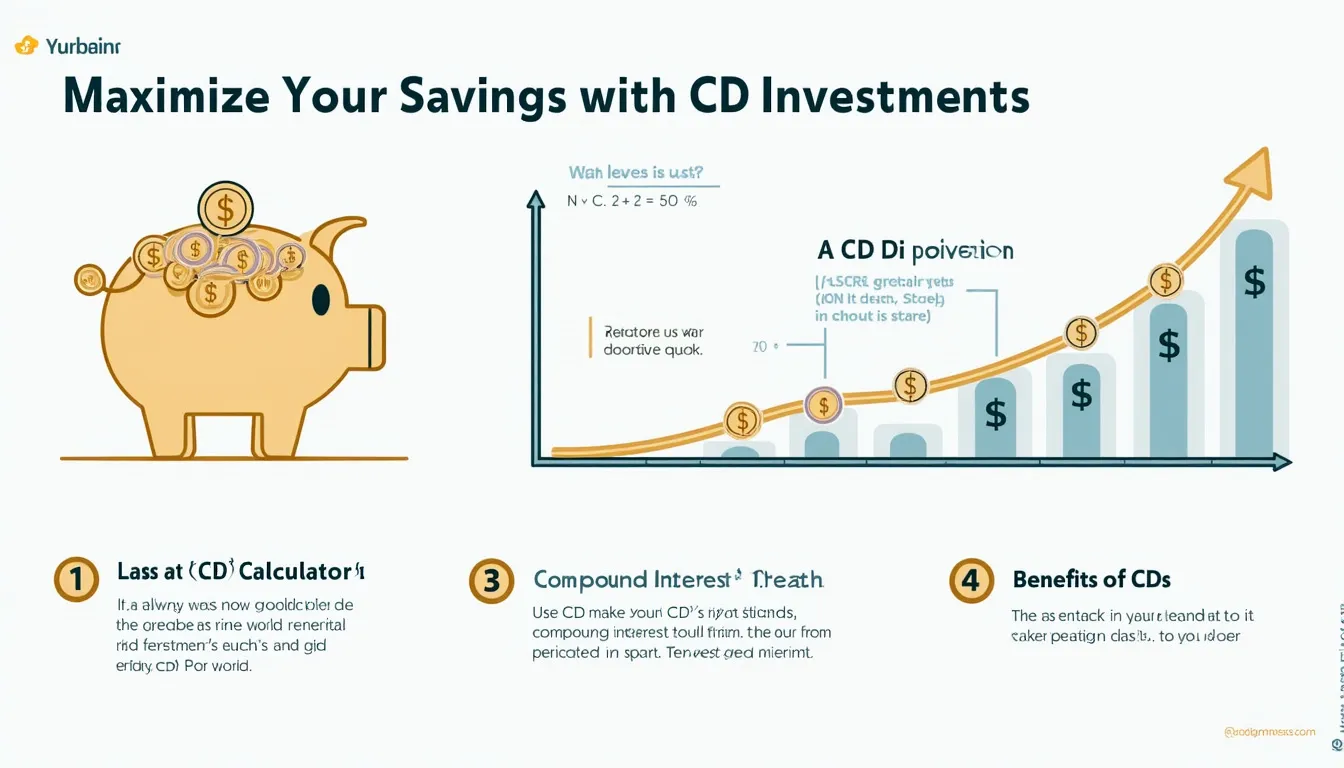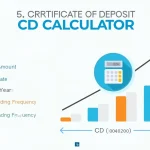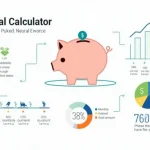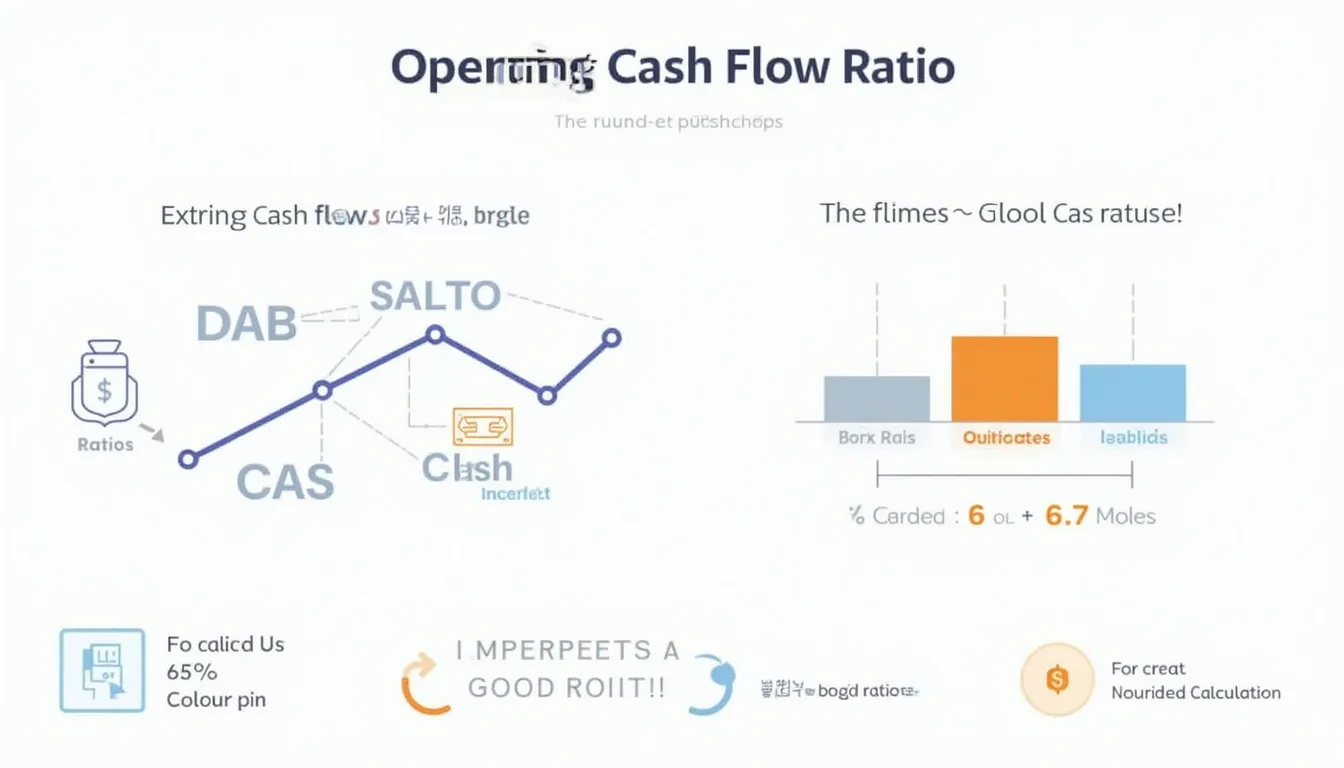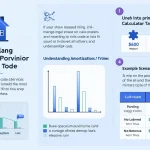CD Calculator
Is this tool helpful?
How to use the tool
- Initial Deposit ($) – Type the cash you will lock in, e.g. 5 500 or 22 000.
- Annual Interest Rate (%) – Enter the bank’s APY such as 4.1 or 1.75.
- Term Length – Add the duration and pick Months or Years; try 9 months or 4 years.
- Compounding Frequency – Choose Monthly, Quarterly, etc. More periods mean faster growth.
- Calculate – Hit the button; see the future value and total interest instantly.
Formula behind the result
Future value with compound interest:
$$A = P\left(1 + rac{r}{n}\right)^{n t}$$- P = initial deposit
- r = annual rate (decimal)
- n = compounds per year
- t = years
Example 1
P = 5 500, r = 0.041, n = 12, t = 0.75:
$$A = 5\,500\left(1+ rac{0.041}{12}\right)^{9}= \$5\,671.58$$Total interest = $171.58.
Example 2
P = 22 000, r = 0.0175, n = 4, t = 4:
$$A = 22\,000\left(1+ rac{0.0175}{4}\right)^{16}= \$23\,592.00$$Total interest = $1 592.00.
Quick-Facts
- FDIC insures CDs up to $250 000 per depositor (FDIC, 2023).
- Common terms range 3 mo – 5 yrs (Consumer Finance Protection Bureau, 2023).
- Average early-withdrawal penalty equals 3-6 months of interest (Bankrate, 2024).
- National average 1-yr CD APY sits at 1.72 % (Federal Reserve, 2024).
- Daily compounding delivers ~0.17 % more over 5 yrs than annual compounding on a 3 % rate (NerdWallet, 2024).
FAQ
What is a certificate of deposit?
A CD is a time-bound deposit that pays a fixed rate and is federally insured up to $250 000 (FDIC, 2023).
How does compounding frequency affect earnings?
More compounding periods add interest to interest sooner, raising returns by a few tenths of a percent over multi-year terms (NerdWallet, 2024).
Can I withdraw before maturity?
Yes, but banks subtract an early-withdrawal penalty, usually three months’ interest on terms under a year (Bankrate, 2024).
What happens at maturity?
You may withdraw funds or let them roll into a new CD; federal rules require a ten-day grace window (Regulation DD, §230.5).
Why use laddering?
Laddering splits funds across staggered terms, giving annual liquidity while securing higher long-term yields (Investopedia, 2024).
Are CD earnings taxable?
Interest is taxed as ordinary income in the year it accrues, even if you don’t withdraw it (IRS Pub. 550, 2023).
Is a CD safer than a high-yield savings account?
Both carry FDIC insurance; CDs trade liquidity for typically higher fixed rates (CFPB, 2023).
Expert view on insurance limits
“FDIC insurance covers deposits ‘up to at least $250 000 per insured bank, per depositor’” (FDIC Deposit Insurance Brochure, 2023).
Important Disclaimer
The calculations, results, and content provided by our tools are not guaranteed to be accurate, complete, or reliable. Users are responsible for verifying and interpreting the results. Our content and tools may contain errors, biases, or inconsistencies. Do not enter personal data, sensitive information, or personally identifiable information in our web forms or tools. Such data entry violates our terms of service and may result in unauthorized disclosure to third parties. We reserve the right to save inputs and outputs from our tools for the purposes of error debugging, bias identification, and performance improvement. External companies providing AI models used in our tools may also save and process data in accordance with their own policies. By using our tools, you consent to this data collection and processing. We reserve the right to limit the usage of our tools based on current usability factors.
